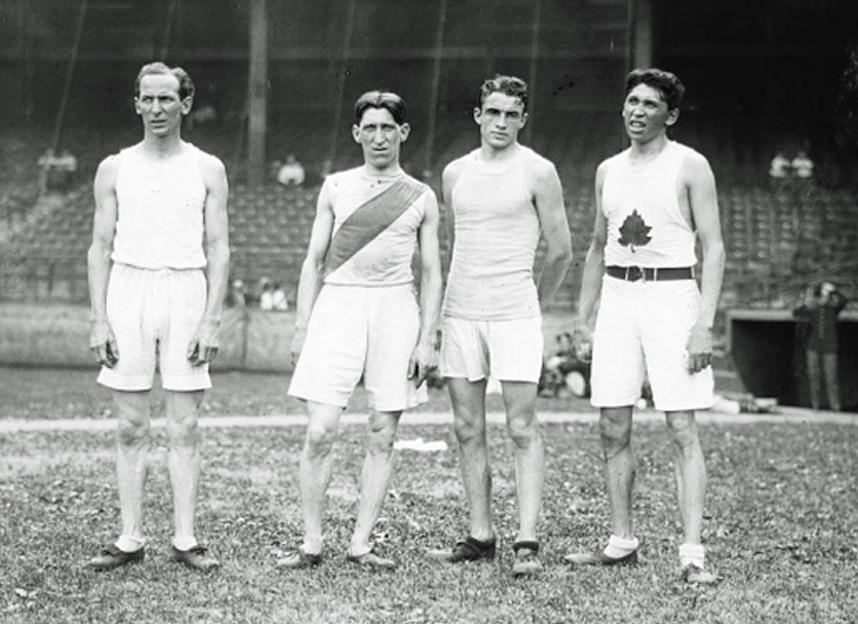Open Wednesday to Saturday, 12 p.m. to 6 p.m.
The Story of Tom Longboat and Longboat Hall
How a popular Toronto venue holds a special place in First Nations and Canadian history.
Nestled on the corner of Queen Street West and Dovercourt Road, The Great Hall is a historical treasure trove among a flurry of new housing and commercial developments. Today, this popular venue hosts concerts, talks, parties, and more. Though home to many lively happenings, few know the story of Tom Longboat and Longboat Hall.
Longboat Hall, one of two concert spaces within The Great Hall facility, was once a YMCA gymnasium surrounded by an elevated track. You can still walk on it today. Its namesake, Tom Longboat (Gagwe:gih), once ran laps around this track while training as a professional distance runner, and in doing so, rose above the competition to become an Olympian, war hero, Canadian icon and one of the most famous First Nations’ athletes in recorded history.

Early Life
A member of the Onondaga Nation, Longboat grew up in the Six Nations of Grand River Reserve, and attended the local Mohawk Institute Residential School. The Canadian Residential School System sought to assimilate Indigenous youth by enforcing a eurocentric, Judeo-Christian model of life, erasing (often through abusive means) the children’s connection to their own culture.
Longboat escaped the school and moved in with his uncle, who hid him from authorities. He eventually met Bill Davis, a Six Nations Mohawk who also competed as a distance runner. Though lacking formal training, Longboat immediately won races in Hamilton and Caledonia. In 1907, with the assistance of Davis and the West End YMCA, he entered the Boston Marathon. Not only did Longboat defeat his competition by half a mile, he shattered the race record by five minutes. In only his third competitive race, Longboat became one of the most famous athletes in the world.
A year later, Longboat represented Canada in the marathon at the 1908 Olympics in London. Though heavily favoured before the race, he struggled and ultimately collapsed in the final quarter. Despite the failure, the race turned distance racing into an international sensation, and in a highly-publicized 1909 competition, Longboat became a distance running world champion.
The Outbreak of WWI
The outbreak of World War I marked a turning point in his life. Longboat enlisted in the 180th Sportsmen Battalion, a military unit rostered by dozens of current and former athletes. Longboat served, quite fittingly, as a dispatch runner, often communicating between units to establish trenches and relay marching orders. He also served as an important figure in Canadian propaganda operations, competing against French and British soldiers in occasional track meets. Still, after merging with the 107th Battalion, Longboat served at Vimy Ridge and Passchendaele, two of the most important battles in modern Canadian history.
Longboat survived World War I without any major injuries, but on multiple occasions, he became a victim of a rather modern weapon: fake news. For one, erroneous reports of his death prompted his wife to remarry before his return in 1918 (though he remarried as well). Secondly, a man from Rhode Island called Edgar LaPlante began touring the United States pretending to be Longboat, duping crowds and newspapers in the process. Following the war, Longboat threatened legal action against the grifter, who spent the 1920s pretending to be a Native American chief in Europe.

Longboat’s Legacy
While he continued to promote distance running, Longboat maintained a lower profile following the war and worked for the City of Toronto while raising four children with his wife.
In 1955, he was inducted into the Canadian Sports Hall of Fame after his death in 1949.
As a world-famous distance runner, one cannot avoid likening him to Pheidippides, the mythical courier who ran to Sparta to seek reinforcements for the Athenians during the battle of Marathon. As someone who defied the forces of expectation, convention and assimilation, though, perhaps Longboat has no historical equivalent.

Explore More
There are vibrant hues hiding in unexpected places around the
A Taste of Beekeeping in Toronto
Learn about urban beekeeping, the city's honeybee population, and partake
Share this Article
Explore More
Content
Urban Colour & Natural Dyes Workshop
There are vibrant hues hiding in unexpected places around the city! Learn the art of creating dyes with the Contemporary Textile Studio Co-Op
A Taste of Beekeeping in Toronto
Learn about urban beekeeping, the city's honeybee population, and partake in a honey tasting!
Conversations on Toronto’s Don River Redevelopment
What is the future of Toronto's iconic Don River?
Mushrooming, Foraging & Native Pollinator Gardens in Toronto
Uncover how Toronto's unique world of plants and mushrooms is right at your fingertips
Untold Stories of Toronto’s Waterfront: A Talk with Author M. Jane Fairburn
A unique talk that invites you to rediscover the past, present and future of life along Toronto's waterfront.
Urban Forest Bathing: A Guided Meditation Session
Come downtown to discover nature blooming through the concrete! Join us for an urban forest bathing experience.
Myseum of Toronto Changes Its Name to ‘Museum of Toronto’
Myseum of Toronto Changes Its Name to ‘Museum of Toronto’ The Museum of Toronto is Toronto’s City Museum Toronto, ON (April 2, 2024) Today, Myseum of Toronto announced it will
Protected: TGW Preview
There is no excerpt because this is a protected post.
Press Releases and Media
Press Releases and Media Museum of Toronto Recent Press Releases Find Usin the News
PAT Market: A Torontonian Grocer and Koreatown Staple
As a landmark independent grocery store, PAT continues to bring Torontonians together over a love for food and a commitment to serve their local community.










